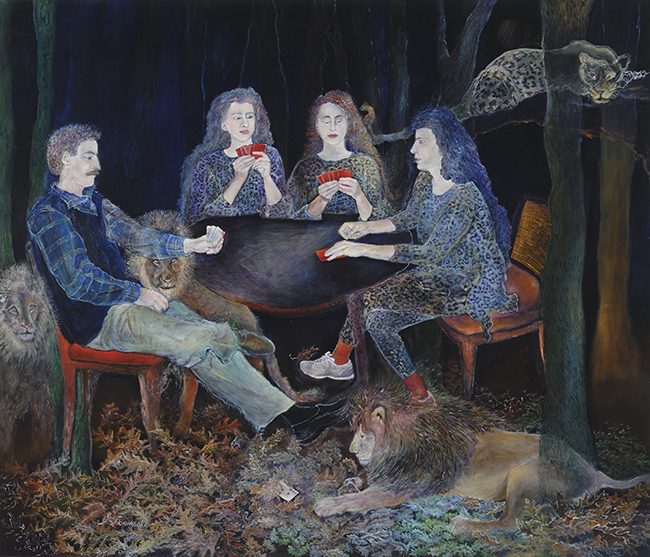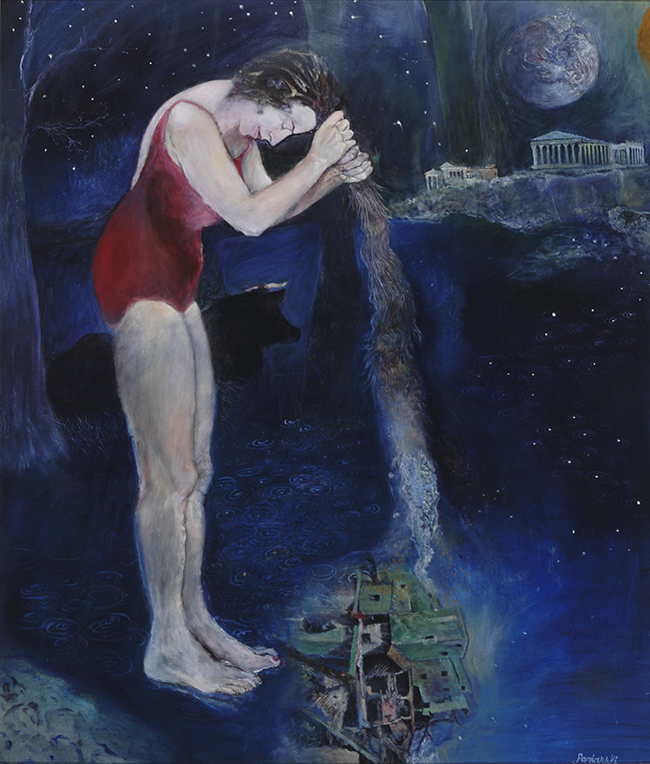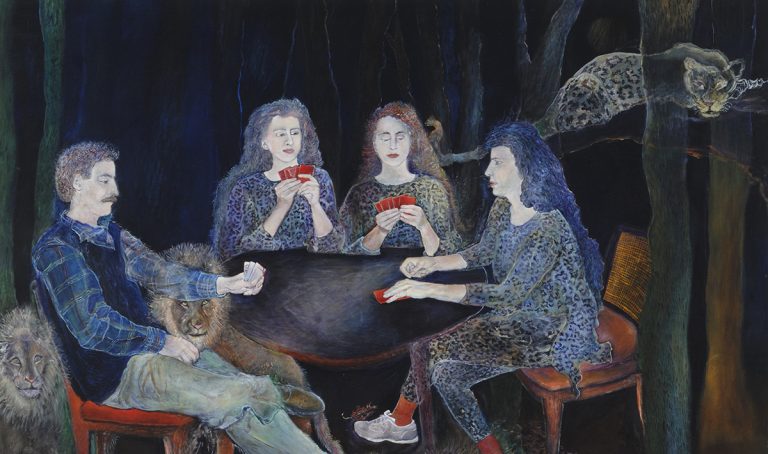Ruth Poniarski, a multifaceted artist, embarked on her creative journey with a Bachelor of Architecture from Pratt Institute in 1982. Following a decade-long stint in the construction field, she transitioned to painting in 1988. This shift allowed her to explore a medium that not only challenged her imagination but also provided a fulfilling means of expression. Through her surreal paintings, Poniarski incorporates elements of myths, culture, philosophy, and literature, thus creating a unique and personal style. Her work straddles the boundaries between dream and logic, reality and allegory — where narratives unfold through deeply psychological and symbolic imagery.
“Who’s Game”

In Who’s Game, Poniarski constructs a mysterious, almost theatrical scene. Four figures sit around a card table in a dimly lit forest, their expressions tense and unreadable. The atmosphere is both familiar and unsettling. The players, dressed in patterned garments, appear engaged in a quiet psychological duel. Lions rest beneath the table and behind the chairs — guardians, perhaps, or manifestations of inner instinct and pride. Their presence transforms an ordinary card game into a symbolic meditation on competition, trust, and dominance.
The forest setting — rendered in dark, cool tones of green, indigo, and umber — deepens the sense of otherworldliness. The light falls unevenly, revealing certain faces and obscuring others, mirroring the way human motives often stay half-hidden. Poniarski’s technique merges precision and mystery; her figures are realistic enough to anchor the viewer but dreamlike enough to invite interpretation.
The interplay between the human and the animal suggests a thin boundary between civility and wildness. Each player seems locked in contemplation — of their cards, of one another, or perhaps of themselves. The lions, symbols of courage and ego, hover as silent reflections of the players’ inner states. Poniarski uses this juxtaposition to explore the animal impulses underlying social games — the power struggles and vulnerabilities that shape even the most mundane human interactions.
What makes Who’s Game compelling is its refusal to explain itself. It offers no clear winner or conclusion, only a haunting tableau of thought and instinct, intellect and emotion. The painting feels suspended in time — a visual metaphor for the constant negotiation between self-control and desire.
“Reflections”

In Reflections, Poniarski turns inward, creating an image of meditative solitude and transformation. A lone woman in a red swimsuit stands over a surreal landscape, wringing water — or perhaps time — from her long hair. The water cascades downward into a blue abyss, where miniature houses appear submerged. Behind her, ancient ruins and celestial bodies hover, evoking a sense of timelessness and existential wonder.
This work feels deeply personal and mythological at once. The figure could represent memory, creation, or renewal. By pouring water into a submerged city, she becomes both destroyer and giver of life — an echo of ancient deities tied to the cycles of nature and emotion. Poniarski’s background in architecture subtly surfaces here: the ruins and structures are rendered with care, as though the artist is both dismantling and rebuilding meaning through paint.
The color palette — dominated by deep blues and cosmic purples — lends the scene a nocturnal serenity. Light emanates softly from unseen sources, illuminating the figure’s skin and emphasizing her vulnerability. The composition draws the viewer downward, following the stream of water, then upward again to the vast sky — an eternal movement between earth and spirit, body and thought.
Through this poetic imagery, Poniarski reflects on the act of creation itself. The figure’s gesture — squeezing out her hair — mirrors the artistic process: a release of inner substance, a yielding of something deeply personal into the world. It’s a quiet, contemplative ritual that bridges the personal and the universal.
Reflections also captures the weight of memory. The submerged houses feel like remnants of a lost world — perhaps personal history or collective experience. Yet they remain visible, touched by the flow of water, suggesting that nothing is ever fully erased; everything transforms.
A Language of Symbolism
Both works reveal Poniarski’s ability to translate emotional and intellectual complexity into vivid imagery. She invites viewers into dreamlike scenes that seem to emerge from the unconscious mind, yet grounded by a sense of design and structure. Her architectural training shows in the way she constructs spatial relationships and balances order within chaos.
At the heart of her art lies an exploration of the human condition — the dualities of control and surrender, intellect and instinct, reflection and confrontation. Whether portraying figures locked in quiet competition or solitary introspection, Poniarski’s world remains one of tension, beauty, and introspective calm.
Her surreal realism doesn’t simply depict fantasy — it questions it. In doing so, Ruth Poniarski transforms painting into a mirror for the unseen forces shaping human experience.

